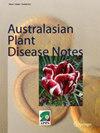Branch canker and dieback of Meryta denhamii caused by Neofusicoccum parvum and Neoscytalidium dimidiatum in Italy
IF 0.6
Q4 PLANT SCIENCES
引用次数: 1
Abstract
A recent survey conducted in the historical botanical garden Villa Caronia, Sicily, identified the causal organisms of branch cankers and dieback on a mature Meryta denhamii. Laboratory isolations and sequencing of three loci, namely ITS, tef1-α, and tub2, showed the presence of two species belonging to Botryosphaeriaceae, including Neofusicoccum parvum and Neoscytalidium dimidiatum. Pathogenicity tests confirmed that these species are able to induce canker symptoms on this host. To our knowledge, this is the first report, worldwide, of N. parvum and Ne. dimidiatum causing branch canker and dieback on M. denhamii.
意大利小新梭形球虫和小新锥虫引起的登氏Meryta分支溃疡和枯死
最近在西西里岛历史悠久的植物园Villa Caronia进行的一项调查发现,在成熟的Meryta denhamii上发现了树枝溃烂和枯死的致病生物。对ITS、tef1-α和tub2三个基因座的实验室分离和测序结果表明,该植物属于botryosphaeriiaceae,包括Neofusicoccum parvum和Neoscytalidium dimidiatum。致病性试验证实,这些物种能够在该宿主上引起溃疡症状。据我们所知,这是世界范围内关于小奈瑟菌和新奈瑟菌的第一份报告。引起野田鼠枝溃烂和枯死。
本文章由计算机程序翻译,如有差异,请以英文原文为准。
求助全文
约1分钟内获得全文
求助全文
来源期刊

Australasian Plant Disease Notes
PLANT SCIENCES-
CiteScore
1.90
自引率
0.00%
发文量
36
期刊介绍:
Australasian Plant Disease Notes is an international journal for publication of short reports from all countries which describe original research that transcends national boundaries. All aspects of plant pathology are covered including new geographical records of diseases or pathogens, new pathogens or pathogen strains, taxonomic papers, quarantine notes, disease management and diagnostic methods. Australasian Plant Disease Notes is a publication of the Australasian Plant Pathology Society.
 求助内容:
求助内容: 应助结果提醒方式:
应助结果提醒方式:


